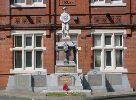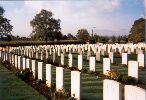
Newton-le-Willows and
Earlestown War Memorial

| OTHER WARS |
 |
Newton-le-Willows andEarlestown War Memorial |
 |
| The
Great War Roll of Honour |
|||||||||||||||||||||||||

John was born in Barrow-in-Furness, the son of George Walker. He married Evelyn Hughes, and they lived at 13, Tamworth Street, Earlestown with their two young children, although CWGC gives his wife’s address after the war as Vine Cottage, Bromlow, Minsterley, Salop.
He was formerly a butcher with Mr. Jackson of Legh Street. He was in the army about sixteen months, twelve of them being spent in France.
John’s obituary published in the Newton and Earlestown Guardian on August 31st 1917 included a letter from a “chum”, Private H. Williamson (16479) of the Lewis Gun Section, 2nd Battalion: “It was on the morning of the 5th August when we were cleaning ourselves up a bit, before being relieved, it being very rainy weather, that he got hit. He had just got up to get his equipment when a shell burst close to, and he was hit by shrapnel in the head and shoulder. He died without saying a word to anyone – a painless death. I daresay you will have seen my name in one of your letters before, as I was his chum. I can tell you I miss him very much, as he helped me on the gun, as well as being my chum.”
John was killed during the Third Battle of Ypres, usually known as Passchendaele. His name is one of over 54,000 officers and men who are recorded on the Menin Gate, Ieper, who died in the Ypres Salient before August 16th 1917 and who have no known grave.
Whalley-Kelly in his book “Ich Dien” describes the conditions for the 2nd Battalion during the opening days of the battle:
“The remainder of June was spent training in a camp near
St. Omer, in exceptionally hot weather, for the forthcoming offensive which
commenced on 31st July and which was preceded by the usual strenuous pioneer
work. During this preliminary preparation the Battalion bore its full share
of the' heat and burden of the day, and for the first time experienced mustard
gas, with which the enemy liberally drenched the back areas.
“The night after the battle commenced found the Battalion once more
near Hooge Chateau, and during the ensuing attack it had a very unpleasant
time in close support, being in full view of the enemy who were in possession
of the higher ground. Casualties began to mount up, heavy rain set in and
the ground became almost impassable; men fell from sheer fatigue and were
drowned in the mud before they could be rescued, and over all raged the ceaseless
torrent of shell from the hostile artillery. The ration parties took all night
to get up to their companies, who were crouching in the shell-holes up to
their waists in mud and water. Again, in the words of Major-General Baird,
"the endurance of the soldiers was magnificent and they were always cheery.
The 2nd P.W.V. had a very trying time. Battalion Headquarters were in a pill-box
which was continuously barraged by the Germans and on one occasion when I
went to see Major Herbert there were 11 signallers, 9 stretcher-bearers and
a Regimental Sergeant-Major lying dead outside."
“Here it must be explained that the task of the 75th Brigade was to
consolidate, and hold, a line on the Westhoek Ridge which had been taken by
troops of the 8th Division on the first day of the battle. This position was
of vital importance to the enemy, and, having failed to retake it by infantry
counter-attacks, he tried to obliterate the defenders with shell fire, the
resulting conditions being as inadequately described. The Battalion, under
Major H. C. Herbert, spent six days in this inferno, during which it was reduced
to little more than 200 rifles, the survivors being exhausted to the last
degree and literally covered in mud from head to foot. It was eventually relieved
on 5th August, and, marching via the Menin Gate, went into bivouac at Swan
Chateau, south of Ypres, where it was found that the total ration strength,
including administrative personnel and the ninety-odd officers and men of
"B" Team, was only 473 of all ranks.”
The 2nd Battalion Diary also indicates the conditions experienced by the men:
“Very misty morning, which developed into fine bright
day. Considerable aerial activity on both sides. Orders received for Batt.
To withdraw from present position at dusk. Situation during the day quieter:
intermittent shelling.
“During the evening the presence of our aeroplanes over the enemy’s
batteries caused him to keep down his fire & taking advantage of this
the Batt. Commenced to withdraw about 7 p.m. moving via BIRR CROSS ROADS,
and MENIN GATE to SWAN CHATEAU about 1½ miles South of YPRES, arriving
there shortly after midnight. All ranks were very exhausted & plastered
with mud. Rifles & Lewis Guns were all choked with mud.
“The trying experiences of the past few days have taxed the endurance
of all ranks to the utmost & the losses enumerated below have considerably
reduced the strength of the Battalion.
“The Bn. Transport has also had a trying time. The continuous rain converted
the lines into a quagmire, both men & animals suffering in consequence.
The work of getting supplies forward was most difficult – roads &
tracks were in a very bad state & the constant shelling of these by the
enemy exposed men & animals to considerable danger. Despite these factors,
supplies were, in every instance, successfully delivered at the Brigade dump,
where they were taken over by carrying parties. The Transport Lines were also
frequently shelled, fortunately, without casualties.
“The parties engaged in “carrying” from BIRR CROSS ROADS
to the positions held by the Bn. did excellent work, which was much appreciated
by all. These parties were commanded by Lieut. C.W.CASTLE & 2 Lieut. P.J.ADAMSON,
until the former was ordered to join his company in the lines owing to the
scarcity of officers, when the entire responsibility devolved upon the latter.
“Summary of Casualties sustained during tour:-Killed. Wounded.
1st Aug 7 O.R. 3 Off. 55 O.R.
2nd Aug 1 Off. 20 O.R 23 O.R.”
There is a reference in a letter from Sergeant Coughlan published
in the NEG of 5th March 1915 to a Private John Walker, aged 22, of Queen Street
St. Helens being killed. This will have been Rifleman
John Francis Walker (2006) of 1st/5th Battalion South Lancashire Regiment
who was killed in action on 21st February 1915 and who is buried at Tancrez
Farm Cemetery. Other than the reference in the letter, there is no obituary
and it is unlikely that this is the J. Walker on the Memorial.